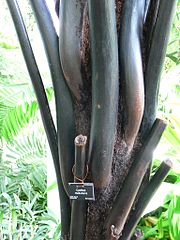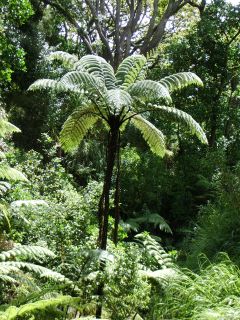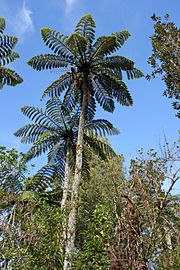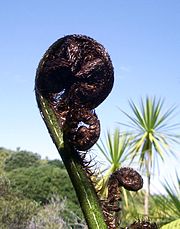- Cyathea medullaris
-
Black tree fern Scientific classification Kingdom: Plantae Division: Pteridophyta Class: Pteridopsida Order: Cyatheales Family: Cyatheaceae Genus: Cyathea Subgenus: Sphaeropteris Section: Sphaeropteris Species: C. medullaris Binomial name Cyathea medullaris
(G.Forst) Sw., 1801Synonyms - Polypodium medullare G. Forster, 1786
- Sphaeropteris medullaris (G. Forster) Bernhardi, 1801
- Cyathea affinis W. J. Hooker & Baker, 1874 (non Cyathea affinis (J. R. Forster) Swartz, 1801, non Cyathea affinis M. Martens & Galeotti, 1842 (cannot be attributed to any species), non Cyathea affinis Brackenridge, 1854; quae Cyathea propinqua)
- Alsophila extensa Desvald, 1827 (non Alsophila extensa Blume, 1828; quae Cyathea raciborskii)
- Alsophila lunulata (G. Forster, 1786) R. Brown, 1827 (non Alsophila lunulata Blume, 1828; quae Cyathea junghuhniana)
Cyathea medullaris, popularly known as the black tree fern, is a large tree fern up to 20 m tall. It is endemic to New Zealand. It is called mamaku, katātā, kōrau, or pītau in the Māori language.
Contents
Distribution
C. medullaris is common in lowland forest throughout the North Island. In the South Island its distribution is more localised. It is fairly common in wetter coastal areas, but rare in the drier eastern parts and absent in Canterbury and Otago. It also occurs on the Three Kings Islands in the far north, on Stewart Island/Rakiura in the far south and in the Chatham Islands.
Description
 The black trunk with characteristic hexagonal stipe bases seen here from this specimen from RBGE, Edinburgh
The black trunk with characteristic hexagonal stipe bases seen here from this specimen from RBGE, Edinburgh
The trunk is black and covered with hexagonal stipe bases. The fronds may be up to 5 m long, and arch upwards from the crown. Dead fronds are shed except in very young plants. The primary pinnae are from 40 cm to 1 m long, and the undersides bear scales with marginal spines. The stipes are thick, black, very rough to the touch, and covered in black scales with marginal spines. C. medullaris can be readily distinguished from related species by the hexagonal stipe scars on the trunk and by the scales with spines on their margins.[1][2]
Cultivation
C. medullaris will grow from fresh spores, but this is slow. Plants are easy to transplant when they are young. It is also possible to plant newly felled trunks which will generally sprout again, provided they are watered with care. They are hardy in various conditions once established.[1][2]
Uses
Tree fern trunks, including those of C. medullaris, have been used as rough building material and also for makeshift trackwork.[2]
Notes
- ^ a b "Cyathea medullaris". New Zealand Plant Conservation Network. http://www.nzpcn.org.nz/flora_details.asp?ID=2097. Retrieved 2010-10-04.
- ^ a b c "Cyathea medullaris (G.Forst.) Sw. (1801)". Ngā Tipu o Aotearoa — New Zealand Plants. http://nzflora.landcareresearch.co.nz/default.aspx?selected=NameDetails&TabNum=0&NameId=ED1E8156-2513-4F9A-BC87-A863C93A57E8. Retrieved 2008-05-02.
Bibliography
- "Cyathea medullaris". New Zealand Plant Conservation Network. http://www.nzpcn.org.nz/flora_details.asp?ID=2097. Retrieved 2010-10-04.
- "Cyathea medullaris (G.Forst.) Sw. (1801)". Ngā Tipu o Aotearoa — New Zealand Plants. http://nzflora.landcareresearch.co.nz/default.aspx?selected=NameDetails&TabNum=0&NameId=ED1E8156-2513-4F9A-BC87-A863C93A57E8. Retrieved 2008-05-02.
- John E.Braggins and Mark F.Large. 2004. Tree Ferns. Timber Press, Inc. ISBN 0-88192-630-2
- C.Michael Hogan. 2010. Fern. Encyclopedia of Earth. eds. Saikat Basu and C.Cleveland. National Council for Science and the Environment. Washington DC.
Categories:- Cyathea
- Fern species
- Ferns of New Zealand
- Trees of New Zealand
- Endemic flora of New Zealand
- Ornamental trees
- Trees of mild maritime climate
- Flora of the Tubuai Islands
- Trees of the Pacific
Wikimedia Foundation. 2010.



